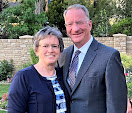"First Dominican Baptism"
Elder Darrel L. Hammon
Not long ago, we attended our first baptism in the Dominican Republic. Elder Lynn and Sister Janet Snow have the opportunity to serve in a little branch, just past Boca Chica, called the Quisgueya Branch. You drive down the Autopista (freeway), past Boca Chica, and then turn left off the Autopista onto a little narrow country road full of potholes. The Snows invited us to go with them to the Quisgueya Branch to a baptism. Of course, we accepted.
On the way, we stopped in Boca Chica and had a late lunch at El Mesón, a restaurant without walls. Joanne ordered a chicken dish with mushrooms, and I ordered pork chops (chuletas). We waited forever for our food, and there weren’t that many people there. The plan was to eat our food and head to the beach, which was just across the street from the restaurant, for a look see before we headed to Quisqueya. They took so long that we didn’t get to do it. Nonetheless, it was all very, very delicious. I just wished we had had more time to savor the food, but we chomped it down like there was no tomorrow because we thought we were going to be late to the baptism.
 |
| The water truck filling the baptismal font. |
The Quisgueya Branch is way out in the campo (in the countryside). We drove quite a ways to get there. The town was very poor, and, of course, the streets were not paved. When we drove up to the little house on the corner that was the church house, nothing had been done about the baptism. We thought for sure that we were going to be late. Not to be. The missionaries arrived, and the font hadn’t been filled yet. The truck that supposed to bring the water hadn’t come although the filling of the font had been previously arranged. So, Elder Snow and the Branch President jumped into the car and headed to the water place. Soon, the truck came with one big barrel of water and filled the piscina (font). Then, it had to go back and get another one. In the meantime, we talked to the kids, took pictures, let them take pictures with our cameras. They were crazy when it came to taking pictures.They must have never done this before, but they had a wonderful time taking pictures.
 |
| Elder Clayton, Marcos, and Elder Green |
The young man getting baptized was named Marcos. Marcos was 24-years-old and was fellowshipped by a young 17-year-old young woman. He was a very handsome young man. As we were chatting, he showed me some of the artwork that he does. It was beautiful. Much of his stuff is murals on walls. I wish I could see some of it in real life. If the murals are as good as the pictures, then he is really good.
It was a wonderful baptism. We had a wonderful talk beforehand by a young woman. We all went to the font where the baptism was performed. There wasn't much water. He had to be baptized twice because his white clothing ballooned up and out of the water. After the first try, the clothes became wet and clingy, thus allowing the second try to succeed. We believe in baptism by immersion, thus the importance of having the person completely submerged. The spirit was strong.
One of the positives at the baptism was the attendance of a young man who told me he was planning on going on a mission. The Snows said this young man has been inactive and is coming back. Having a young man from a branch like this go on a mission is an incredible thing. He would be one of the strongest leaders in his branch, even in his area. |
| Marcos and the young woman who was instrumental in bringing him to the church. |















